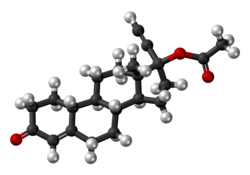 | |
 | |
| Clinical data | |
|---|---|
| Trade names | Primolut-Nor, Aygestin, Gestakadin, Milligynon, Monogest, Norlutate, Primolut N, SH-420, Sovel, Styptin, others |
| Other names | NETA; NETAc; Norethindrone acetate; SH-420; 17α-Ethynyl-19-nortestosterone 17β-acetate; 17α-Ethynylestra-4-en-17β-ol-3-one 17β-acetate |
| AHFS/Drugs.com | International Drug Names |
| MedlinePlus | a604034 |
| Routes of administration | By mouth |
| Drug class | Progestogen; Progestin; Progestogen ester |
| ATC code | |
| Legal status | |
| Legal status |
|
| Identifiers | |
| |
| CAS Number | |
| PubChem CID | |
| DrugBank | |
| ChemSpider | |
| UNII | |
| KEGG | |
| ChEBI | |
| ChEMBL | |
| CompTox Dashboard (EPA) | |
| ECHA InfoCard | 100.000.121 |
| Chemical and physical data | |
| Formula | C22H28O3 |
| Molar mass | 340.463 g·mol−1 |
| 3D model (JSmol) | |
| |
| |
| (verify) | |
Norethisterone acetate (NETA), also known as norethindrone acetate and sold under the brand name Primolut-Nor among others, is a progestin medication which is used in birth control pills, menopausal hormone therapy, and for the treatment of gynecological disorders. [1] [2] [3] [4] The medication is available in low-dose and high-dose formulations and is used alone or in combination with an estrogen. [5] [4] [6] [7] It is ingested orally. [6]
Contents
- Medical uses
- Available forms
- Contraindications
- Side effects
- Overdose
- Interactions
- Pharmacology
- Pharmacodynamics
- Chemistry
- Synthesis
- History
- Society and culture
- Generic names
- Brand names
- Availability
- Research
- See also
- References
Side effects of NETA include menstrual irregularities, headaches, nausea, breast tenderness, mood changes, acne, increased hair growth, and others. [6] NETA is a progestin, or a synthetic progestogen, and hence is an agonist of the progesterone receptor, the biological target of progestogens like progesterone. [1] It has weak androgenic and estrogenic activity and no other important hormonal activity. [1] [8] The medication is a prodrug of norethisterone in the body. [9] [10]
NETA was patented in 1957 and was introduced for medical use in 1964. [11] [12] It is sometimes referred to as a "first-generation" progestin. [13] [14] NETA is marketed widely throughout the world. [4] It is available as a generic medication. [15]

